Care features
This plant is quite capricious and will require a lot of time and care. Consider the basic requirements that must be met in order for the flower to delight with lush greenery and beautiful flowers.
Lighting
- The north side, the dark place and the small windowsill are not suitable for Stefanotis.
- Liana grows and develops quite quickly, so it is better to immediately pick up a well-lit and spacious place.
- However, in summer, it is necessary to shade the plant a little so that the strong sunlight does not burn the leaves.
- Stephanotis needs a lot of sun, so consider additional lighting in the form of lamps in winter.
Temperature regime
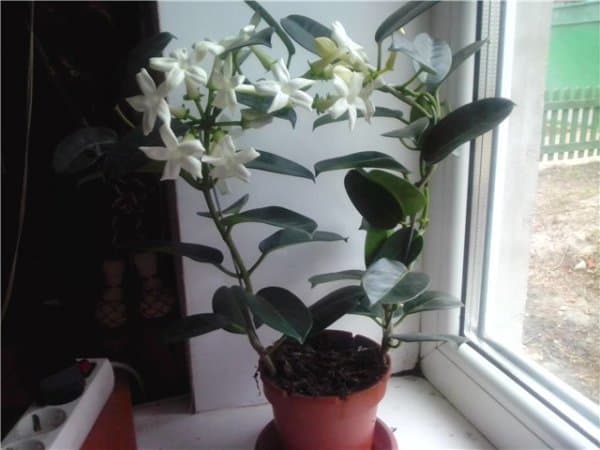
This decorative flower tolerates heat extremely negatively. Temperatures above +25 degrees are unacceptable for him. He overheats and then starts to hurt. Also, the plant does not tolerate the products of gas combustion, so it is better not to put it in the kitchen. Protect Stefanotis from drafts and dampness.
In winter, +15 degrees is the most acceptable temperature for growing this decorative flower. After such wintering, the plant blooms more abundantly and longer. Do not put the flowerpot near heaters or radiators.
Watering
Prepare filtered, settled and not cold water to moisten the soil. In the summer months, water should be at least 2 - 3 times a week.
In winter, one watering every 7 days will be enough.
Experienced flower growers advise regularly wiping the leaves with a damp cloth and giving the plant a warm shower or, in extreme cases, spraying with a rain method.
Important: it is strongly not recommended to use leaf polishes.
Fertilizer
Be sure to apply organic matter and mineral fertilizers. It is recommended to alternate them and apply them to the soil every 14 days, from early spring to the end of the summer period. Top dressing is not applied when the creeper has a dormant period: in autumn and winter.
Fertilize for the first time when you see that the plant is developing well and has not been transplanted for a long time. If the soil is fresh, then this is enough for active growth, and additional nutrition is not necessary.
Growers advise not to touch the flower, not to turn or change its location at the moment when flowering begins. Stefanotis can simply throw off flowers and buds that have not yet opened.
Pruning rules
- Flowering occurs in a plant exclusively on newly appeared branches. Therefore, before starting active growth, it should be cut off a little. It is also recommended to pinch the upper parts of the shoots so that the flowering is more abundant and lasts longer.
- An important point is the timely tying of the shoots. The crown should be formed when the plant and branches are still young. Many people use small arches. Then the shoots become lignified and it becomes difficult to form the correct crown.
- You can use a plastic ladder or a self-made wire support as a support.
Transfer
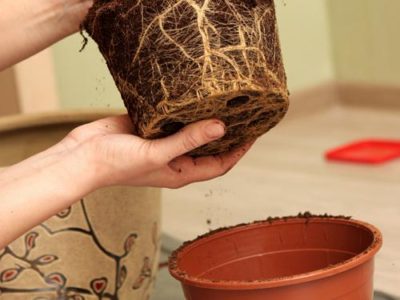
- This procedure should take place in the second half of February, once every 2 - 3 years.
- Adult plants regularly need to change the top layer of the soil and correctly install the support so that it holds the branching shoots of the vines.
- The flower grows best in heavy soil. Before transplanting or planting, prepare your own soil mixture: 3 parts of humus or peat, 2 parts of river sand, 1 part of clay soil and 1 part of deciduous soil.
- The acidity level should be 5.5 - 6.5.
- The pot needs to be selected wide enough. Place a fairly thick layer of drainage on the bottom.Small pebbles, rubble, pieces of styrofoam, or small stones will do.
- After transplanting the flower, add the required amount of soil to the pot and tamp it a little to avoid voids.
- Stefanotis should never be transplanted when it blooms. You need to wait for the plant to completely bloom.
Stephanotis transplant

The optimal period for transplanting Stephanotis is early spring, before the budding period. Young plants are transplanted into larger containers annually. The transshipment method is used.
Adult flowers can be replanted once every two or even three years.
A good drainage layer should be laid out at the bottom of the container, which will facilitate the flow of water.
The transshipment method for transplanting a plant was not chosen by chance.
The root system of stephanotis is formed by a large number of small roots, which, if handled carelessly, are easily deformed and damaged. As a result, the plant is deprived of the opportunity to receive water and nutrients from the soil, and this leads to wilting of the shrub.
The problem can be solved by spraying so that moisture reaches the plant not through the root system, but through the leaves.
Watering in the first few weeks after transplanting should be very careful. Excessive moisture contributes to the death of the entire plant. For the speedy rooting of stephanotis, growth stimulants can be added to the water.
Reproduction
There are 2 ways to reproduce stephanotis at home:
- sowing seeds;
- grafting.
This vine is rarely propagated by seeds. This is a rather laborious and lengthy process. Purchased stefanotis seeds are soaked in warm water for 1 day. Then they are laid out in a container on a moistened substrate (a mixture of perlite and leaf humus in equal parts).
The seeds are not buried, but only pressed into the ground. The container is covered with glass from above. The soil is moistened from the sprayer as it dries. Seeds germinate from 1 to 2 months. The sprouts dive into separate pots after they have 3 leaves.
Cuttings are the main method of propagation of this plant at home. Cuttings are harvested during the spring planned pruning. Cuttings with 2-3 internodes are best rooted, the cut of which is made near the lower pair of leaves.
For early rooting, cuttings are treated with root growth stimulants. Then they are dropped into a container with a mixture of peat and sand. The container is covered with glass and placed in a warm place with a stable temperature of 25 ° C. The substrate is watered as it dries, and the glass is removed daily for airing for 0.5-1 hour. The cuttings take root in 1-1.5 months.
Care features
Stafanotis at home requires strict adherence to the rules of care, patience and care.
It is important to remember that the sap of the plant is quite pungent and can be irritating. Florists with sensitive skin are advised to take care of Stephanotis with rubber gloves
Lighting and location selection
Southerner Stephanotis loves light and sun, but not direct sunlight, which can cause burns on its leaves.
In the hot season, it is advisable to keep the flower on the west or east window. If he settles on the southern windowsill, he will need to be shaded from the active sun.
A heat-loving plant does not like overheating. In summer for him, the temperature should not exceed 23 ° C, and in winter it loves a light cool - about 15 ° C.
With a lack of lighting, Madagascar jasmine stops blooming. But if you organize lighting for it in winter, Stephanotis will be able to delight its owners with the exquisite beauty of delicate flowers all year round.
You need to keep it on a window that is not used for ventilation, especially in winter. During the appearance of the ovary, the flower should not be rearranged from place to place and even turned from side to side in order to avoid the termination of flowering.
Air humidity and watering
Stefanotis comes from humid subtropics, therefore it prefers high humidity. It is necessary to place the plant as far away from the batteries as possible in winter and try to provide it with artificial moisture.
You can put containers of water next to it or regularly humidify the air around the plant from a sprayer.
Madagascar jasmine loves daily abundant hydration during the warmer months. You need to spray it with clean, slightly warm water, trying not to fall on delicate inflorescences.
In winter, it is advisable to moisturize the flower with care and not so abundantly. From spring to autumn, stephanotis is watered with soft water at room temperature once every 2 days
You will find methods of dealing with pests of indoor plants and tips for prevention in our article.
Read about the features of caring for a philodendron here.
To provide the flower with constant humidity in summer, you should put the plant pot in a container with gravel and water poured into it. All that remains is to ensure that the gravel is always wet and the bottom of the pot is dry. In winter, the flower is watered every 7 days.
Soil and transplant
The capricious Stephanotis prefers a slightly acidic soil with a complex composition. For normal plant growth, the following mixture is made: peat or humus, sand, clay and deciduous soil in a ratio of 3: 2: 1: 1.
The alkaline composition of the earth can interfere with the flowering of Madagascar jasmine.
Stephanotis is transplanted only when necessary.
A flower transplant is carried out as follows:
A heavy ceramic pot is chosen with a diameter of 1 cm larger than the old one - it should be noted that Stephanotis has a powerful root system.
It is important not to forget to put drainage on the bottom of the pot so that there is no stagnant water.
Stephanotis is transplanted into a new pot by transshipment with an old clod of earth left so that small roots do not get damaged or break off, otherwise the flower may wither
If this does happen, you need to add root growth stimulants to the water for irrigation.
Small roots will grow back quickly and the plant will come to life.
After transplanting, the plant should be watered with caution, avoiding an excess of water in the roots. It is better to spray more often.
In the middle of summer, to prolong the abundant flowering, the shoots of Stephanotis need to be pinched, leaving 8 pairs of leaves on the stems.
Vine formation
Stefanotis is attractive to many flower growers in that it can form an original plant shape from it, making the correct pruning.
It can grow as a compact bush or a long, branching liana that flanks a wall. The flower is cut in early spring.
Damaged and weak shoots are removed first, and other stems can be cut to half the length. It is advisable to cut the main stem as little as possible.
Stephanotis is afraid of strong pruning, so you need to do it with caution, otherwise it may not recover
Plant feeding
It is advisable to feed stephanotis only in the spring-summer period twice a month with fertilizers for flowering plants. In winter, it is better to give the flower a break from feeding. In the spring, when forming buds, fertilizers with a low nitrogen content should be chosen.
Types of stephanotis home with photos and names
There are 15 known species of Stephanotis. Only one species is fully cultivated - profusely flowering Stephanotis.
Stephanotis floribunda (Stephanotis floribunda)
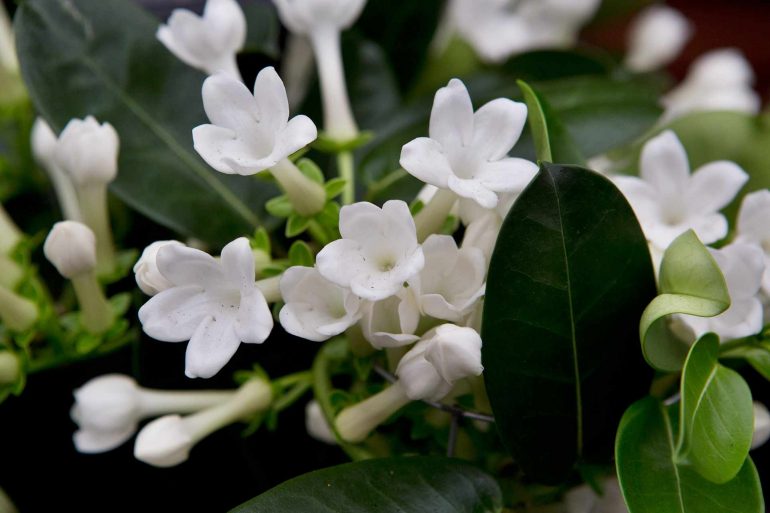
It is also called a waxed flower. An evergreen liana that grows up to 5 meters or more. Large (can reach the size of a human palm). dense glossy leaves are colored green. It blooms luxuriantly with fragrant white or creamy tubular flowers. Corollas consist of 5 petals, can reach 5 cm in diameter. Flowers are collected in loose bunches. Up to 7 buds can grow on one shoot.
Variegated Stephanotis (Stephanotis floribunda variegate)
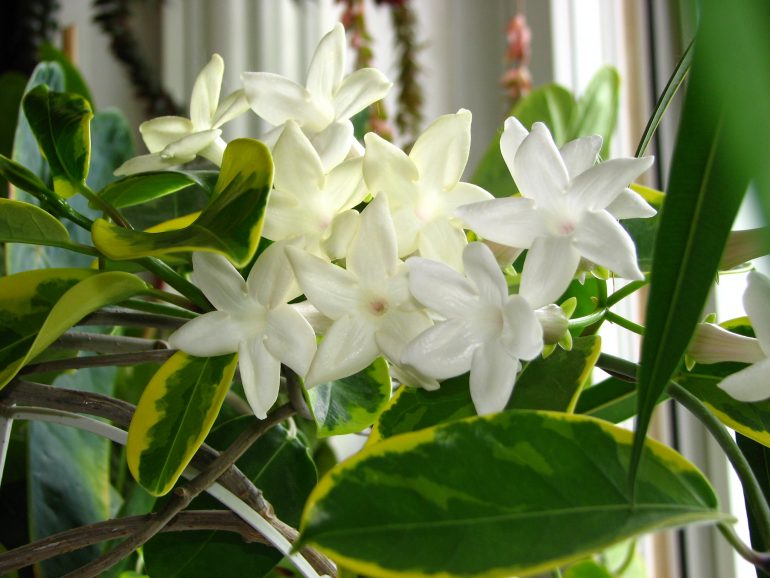
A variety of profusely flowering Stephanotis.The tips of the green leaves seem to be smoothed out. Light green, yellow, white spots and stripes stand out against the green background of the leaf plate.
Stefanotis is still rarely found in apartments: when choosing a plant, florists restrain its capricious nature. But all the difficulties of growing and troubles will pay off with luxurious flowering and refined aroma of a guest from the tropics.
Not many have yet managed to get acquainted with a native of Africa - the stephanotis flower, or, as it is also called, indoor jasmine. At first glance, caring for it seems difficult, but Russian amateur flower growers have proven the opposite: the flower can be grown not only in greenhouses, with proper care it will delight you in an ordinary home environment. What does stefonotis floribunda expect from you: home care, and what diseases does it need to be protected from?
Pests
All houseplants suffer from spider mites and stephanotis is no exception. This small insect is extremely prolific and tenacious, sucks juice from the plant at a sprint speed and adapts to poisons. Destroying it is not easy. Clutches of eggs are left not only on the leaves and the ground, but also in the crevices of window sills and frames, on greenhouse trellises.
Appears in dry air as a result of improper care (at humidity above 80%, the mite dies).
First, rinse the flower in the shower, covering the soil with a film. This will help get rid of the adults. After: remove wilted leaves and stems, and use any folk remedy (provided that the plant is not severely damaged): turpentine, gruel of garlic and onions, a solution of green or tar soap, infusion of dandelion or calendula.
If there are many pests, chemicals (Apollo, Nissoran, Oberon, Flumayt, Sunmayt, Floromite, Kleschevit) or biological products (Aktofit, Vertimek, Akarin "," Fitoverm "). The number of treatments is at least 3 with an interval of 3-6 days.
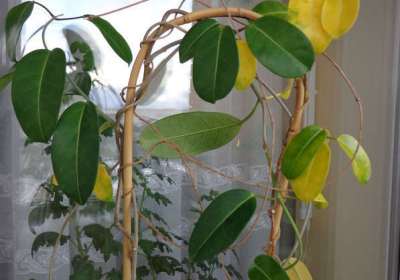 Aphids are no less dangerous for Stephanotis. Prefers young plants, since it is not able to pierce a rigid leaf plate with its proboscis.
Aphids are no less dangerous for Stephanotis. Prefers young plants, since it is not able to pierce a rigid leaf plate with its proboscis.
Brown spots appear on the leaves, the plates are deformed, covered with honeydew, gradually - with a sooty fungus.
From folk remedies, soap solution (4-5 tablespoons of soap shavings per liter of warm water), ash infusion (a handful of 5 liters), tobacco infusion (a glass of makhorka insist 5 liters of boiling water for a day) helps well. From chemicals: "Karbofos", "Aktara", "Intavir". Remember: young plants can die from treatment with chemicals, therefore, in case of mass destruction, propagate by cuttings.
Signs and superstitions
The opinions of superstitious people regarding Stephanotis vary greatly. Up to the point that one omen calls the flower "muzhegon", and the other promises that its flowering foreshadows an imminent marriage. According to one version, the presence of a plant in the house will provide mutual understanding among household members and eliminate quarrels, according to another, the compilers of reference books recommend isolating the plant from the husband, for example, keeping it in a room where a man rarely enters.
Bioenergy therapists generally recommend starting this plant at home if you want to reduce the concentration of destructive energies. They believe that it harmonizes space and dampens outbursts of anger.
There is no unequivocal opinion, so everyone has the right to decide what signs to believe in.
Diseases and pests
The plant can infect several pests, the most dangerous of which is the worm: the leaves are covered with a white downy bloom. On the underside of the leaves, you can see its colonies, it sucks the juice from the plant.
Leaves should be wiped with a cotton swab moistened with ethyl alcohol, followed by chemical treatment. Ladybugs destroy the pest well.
 When damaged by a scabbard, a sticky secret left by a pest and spots (reddish or yellow) are visible on the leaves.For treatment, the plant is treated with soapy water, followed by treatment with insecticidal preparations.
When damaged by a scabbard, a sticky secret left by a pest and spots (reddish or yellow) are visible on the leaves.For treatment, the plant is treated with soapy water, followed by treatment with insecticidal preparations.
The spider mite leaves a cobweb on the plant, which must be removed and the plant treated with Fitoverm. And as a preventive measure, the humidity of the air should be increased.
If the rules for caring for a plant are violated, signs of non-infectious diseases can be observed. In winter, leaves can fall off, this is considered normal - up to 50% of Stephanotis can drop.
With sufficient light, sprouts will emerge from the buds. Over-watering the leaves can become dull and drooping. You should get the plant out of the pot, check the condition of the roots. If there are no changes, the plant must be transplanted into dry ground.
The plant does not bloom for various reasons. Often blooms profusely due to the large amount of fertilizer received. To start blooming, you can feed more often or increase the dosage of the applied potassium fertilizer.
With insufficient watering, drafts, the buds may fall off. Flowers may not appear due to temperature changes or poor lighting, and with insufficient watering, the buds may wither without opening. Watering with hard water will result in yellow leaves.
And for those who like to know more, we suggest that you familiarize yourself with the video about Stefanotis
Growing conditions for indoor stephanotis
Extreme sensitivity to any negative factors makes Stephanotis one of the most capricious indoor plants. When selecting conditions, not only lighting and temperatures are important, but also "little things" - the absence of drafts, access to fresh air, the duration of daylight hours.
Stefanotis are good crops for lobby, hall, staircase, rooms with a cool environment during the cold season. In living rooms, they are usually kept only from spring to autumn, moving to cool rooms for a dormant period. It is believed that the full beauty of Stephanotis can only be appreciated in greenhouses and conservatories, where the plant can be used in its natural form and allowed to drape large areas.
When handling Stephanotis, it is worth considering its status as a poisonous plant. The danger is mainly represented by irritating substances in the sap of the plant, which cause unpleasant inflammatory reactions of the skin and mucous membranes.
Lighting and placement
Stefanotis is a light-loving vine, which, despite all the apparent rigidity and firmness of the leaves, does not react well to direct sunlight. For this plant, it is worth choosing light areas with diffused lighting. The best place for a plant has always been and remains the eastern and western windowsills, but only in summer. In the cold season for this vine, the intensity of illumination in these places may not be enough.
The best flowering stephanotis demonstrate if they are provided with diffused lighting on the southern windows or bright diffused lighting in winter gardens. Even the slightest shading, lack of light or short daylight hours are manifested in the intensity of plant growth. Compensating supplementary lighting for this culture is not only acceptable, but also desirable. Stefanotis, even during the dormant period, remains a plant of long daylight hours (minimum duration - 12 hours).
Stability, the absence of any sudden changes in lighting, is critical at the budding stage. The plant cannot be displaced or rotated in relation to the light source
Even if stephanotis is rearranged for leaf cleaning procedures, it is important to ensure that the plant remains in the same place and in the same position after returning.
Temperature control and ventilation
Stephanotis love restrained, stable warm conditions with slight fluctuations in air temperature during the summer. The liana achieves the greatest decorativeness if the temperature values do not go beyond the range from 18 to 22 degrees.Stephanotis reacts very badly to heat, even a short-term increase to 25 degrees, and even more so, can lead to a loss of decorativeness of the leaves.
The main condition for the flowering of Stephanotis is a cool wintering. This plant is afraid of extreme cold, temperature drop up to 10 degrees. But an excess of the temperature value beyond 16 degrees will lead to a violation of the normal course of the resting phase and the absence or more scarce flowering of Stephanotis. For wintering, the optimal temperature range is from 12 to 16 degrees Celsius.
One of the most difficult moments in the selection of conditions for Stephanotis is his fear of changes in temperature. And during the rest period, and during the period of active development, any drops of more than 2 to 3 degrees can cause developmental disorders or health problems.
Stefanotis, literally, needs to be protected from any stress
Particular attention to protection against temperature extremes should be paid with the beginning of budding and the flowering stage. This sensitivity to change must somehow be combined with constant ventilation: without access to fresh air, Stephanotis quickly becomes depressed.
This vine does not tolerate polluted air, cannot be used in the kitchen or grow in contact with tobacco smoke.
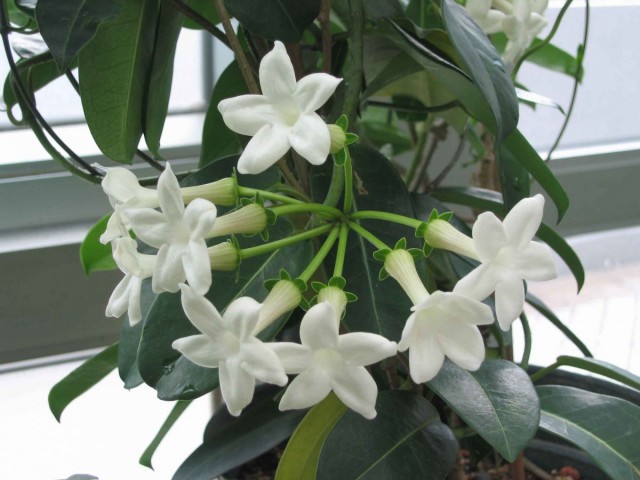 Stefanotis can only bloom in a well-lit place. HQ
Stefanotis can only bloom in a well-lit place. HQ
Diseases and pests of Stephanotis
Stephanotis is a capricious plant. During cultivation, you can face various problems.
- Falling buds. Associated with a lack of light, insufficient watering.
- Slow growth. In most cases, it indicates a lack of nutrition. The plant is transplanted and fed with mineral fertilizers.
- Leaves drooping and darkening. Associated with low indoor temperatures.
- Mealybugs, aphids, scale insects. The most common pests of stephanotis. They fight against them by treating the plant with anticoccidal drugs, wiping the affected leaves with soapy water.
The complexities of growing Stephanotis pay off with a beautiful, abundant and long flowering.
Stephanotis transplant
It is necessary to transplant the plant into a new pot in early spring - after the first pruning annually, and the old ones once every two years. Adult plants can be placed in pots 12-15 cm in diameter, but young ones that continue to develop and grow should be placed in larger pots, for example, with a diameter of 20-25 cm.if the plant is too old or difficult to move (that is, it is dangerous to replant ), then simply replace the topsoil in the pot or place in the bath with fresh mixture. The transplant of Stephanotis should be carried out during the resting period. An earlier transplant of Stephanotis can damage the root system and there will be no flowering next year.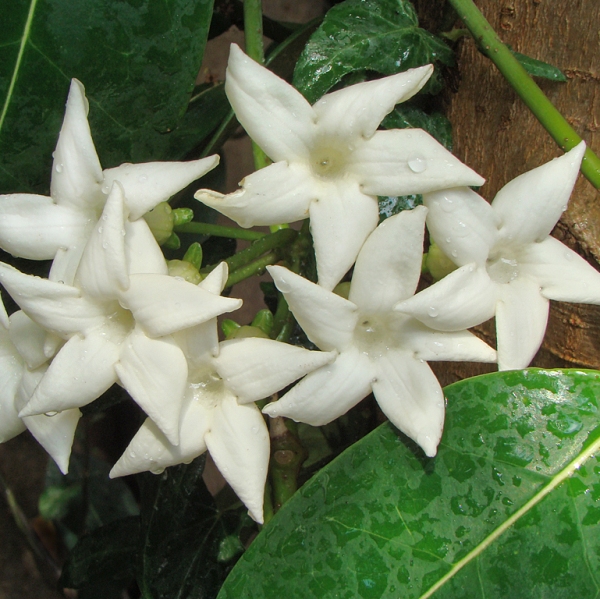
Conditions of detention: temperature, lighting, air humidity
This plant is thermophilic, but does not tolerate heat. The ideal temperature for keeping it in the summer is between 20 and 25 ° C. At a higher temperature, the vine is depressed, grows poorly and does not bloom. In winter, the room temperature can be reduced to 15 ° C.
In nature, Stephanotis grows under the cover of tall trees. He does not tolerate direct sunlight. Burns are easily formed on its leaves. Grows well in diffused lighting. But you cannot grow it in partial shade or shade - with a lack of light, buds are not formed. In winter, it is advisable to place the flower in a more illuminated place. To increase daylight hours, you can create artificial lighting.
Stephanotis is native to the humid subtropics. The air in a city apartment is too dry for him. For good growth and flowering, spraying and artificial increase in humidity are necessary. The liana is sprayed with warm water, while moisture should not get on the inflorescences. To humidify the air, the pot with the plant is placed in a deep tray filled with wet sand, moss or expanded clay.
The plant is afraid of drafts and sudden changes in temperature. It must be kept in that part of the room where air movement is minimal. Do not place a flower near heating devices or air conditioners
Trimming and supporting
To maintain the decorative appearance of the vine and its formation, pruning is carried out. This is done in early spring before the start of the growing season. With pruning, you can create a bushy plant shape or leave it as a long vine with one or more branches. Pruning also stimulates flowering, as buds appear only on new shoots of the current year.
During spring pruning, all dry and damaged shoots are removed. Weak and elongated branches are also cut. When creating a bush form, 4-5 strong branches are left, which are cut in half to stimulate branching. The ampel form provides for 2-3 long shoots, which are slightly shortened to form lateral shoots.
When growing a plant in the form of a long liana, a support is needed to fix the stems on it. Supports of various shapes are available at flower shops. The most popular and beautiful are the arched supports. When creating vertical gardening, the branches of Stephanotis are fixed on the wall. Growing up, such a vine can beautifully braid the entire wall of a room.
Stephanotis must not be cut too much. Its shoots are shortened by no more than 1/2 of the length. Heavy pruning of a plant can lead to its death, as it will not recover.
Features of growing Stephanotis at home
Microclimate and lighting
Stefanotis is a fast-growing and unpretentious plant, but does not like temperature changes. In winter, it is kept in cold greenhouses with a temperature of 12-16 ° C and bright lighting, but without drafts. In summer, they shade from direct sunlight, spraying leathery leaves in the heat. In a dry room with high temperatures in winter, stephanotis can be damaged by spider mites.
If the leaves of Stephanotis turn yellow and begin to fall off, the reason may be lack of lighting or problems with the root system, it may be necessary to transplant into a larger pot with fresh soil. In the summer, Stefanotis is taken out to the glazed loggias, which the plant fills with beautiful flowers and aroma.
Watering
Watering Stephanotis loves regular and abundant, soft water
In winter, after flowering, it is watered sparingly, avoiding the drying out of the earthen coma in the pot, it is important that the soil in the pot is constantly wet, but puddles should not be diluted, it is necessary to spray the air around the plant more often
Soil and fertilizer
Planting and transplanting of stephanotis is carried out in a heavy soil mixture. For the preparation of the soil, deciduous, clay-soddy soil, peat (or humus) and sand are used in a ratio of 3: 2: 1: 1. The dishes are selected large and capacious - Stephanotis has a powerful root system, and drainage is provided at the bottom. This plant prefers soil with a slightly acidic reaction, an alkaline environment can lead to the absence of flowering in Stephanotis. In spring, during transplantation, the stems of Stephanotis can be cut in half. Flowering usually occurs from June and lasts until September. And in order to prolong abundant flowering, in the middle of summer, its shoots are pinched, leaving up to 8 pairs of leaves on the stem.
Stefanotis does not require frequent feeding, and prefers potash fertilizers more than nitrogen fertilizers. From nitrogen, it builds up stems and leaves, does not bloom and hibernates poorly, not having time to stop growth, later such lashes of Stephanotis have to be completely cut off, slowing down the moment of flowering also next year. Flowering is stimulated by mineral flower fertilizers with trace elements, or solutions of potassium salt and superphosphate, which are applied 1-2 times before flowering in May. Can be watered with mullein solution.
Description of Stephanotis and his photo
As it grows, an evergreen shrub can grow up to 4.5 meters in height and usually branches in several directions.The stems can far exceed this growth, but the process can be controlled by periodically pruning and removing any growths around them. Stephanotis, judging by the description of botanists, is not the easiest plant to reproduce at home. But if there is a window where he can get enough light, then this will very well affect the flower. In the conditions of our region, it is best to grow it in a greenhouse or in a winter garden, where they will look as attractive as possible with elegantly hanging flowers.
You can see various photos of Stephanotis with different colors and colors of leaves:
White, waxy, tube-shaped flowers appear in star-like clusters on a peduncle or cluster of legs (a small group of trunks, each of which produces a flower attached to the stem). They can bloom at any time of the year in an indoor environment with ample light, warmth and humidity, although they bloom most often in spring and summer, especially outdoors.
Indoor flowers Stephanotis rarely do well in temperate regions indoors and outdoors. It is most likely to bloom if you provide it with a cool room during the winter (dormant period) and warm in summer and spring with above average humidity. You can often observe a picture - buds appear, and then fall off before or after the still closed flowers turn yellow. If transferred to a cold room, it can cause the flowers to fall off before full bloom.
To get a good result, with bright and beautiful flowers, you need to work long and hard - flowers do not always appear immediately.
The foliage on the stephanotis vine blooms very well, even when there are some flowering problems, and most often they appear in pairs in opposite directions. During growth, they are large, even while the bush itself is small. The leaves are oval in shape and are up to 10 centimeters in length, and can be longer and have a glossy appearance.
On the inside, it has the same attractive look.
The stems are thick and woody, but flexible enough to form a ball around the wires, which form a petiole behind the leaves.
When buying, pay attention to the appearance of Stephanotis - good, healthy green foliage. The bush has two or three clusters of buds, preferably with one or two flowers
Pay attention to whether the buds are fallen or not.
Some of the varieties have elongated fleshy fruits (especially during warm summers). It can reach 10 or even more centimeters long and have the shape of a pear (only they are not edible). The fruit will take several months to ripen, and if necessary, you can place them in a warm room to fully ripen. After the end of the process, they turn brown and begin to divide. At this stage, the two halves can be pulled apart to reveal a central mass of flattened seeds that have a silky train of white hairs attached to one end. In winter, seeds should be stored in a dry, ventilated area.


